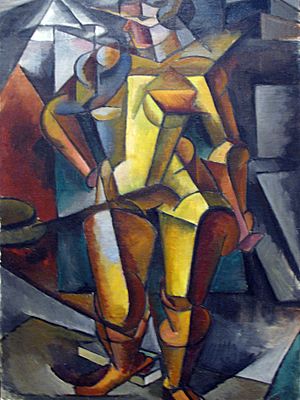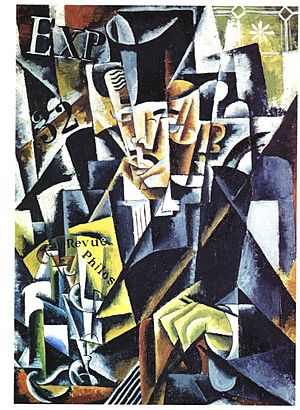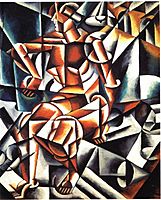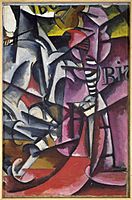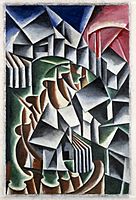Lyubov Popova facts for kids
Quick facts for kids
Lyubov Popova
|
|
|---|---|

Lyubov Popova, before 1920
|
|
| Born | April 24, 1889 Ivanovskoe, Russian Empire
|
| Died | May 25, 1924 (aged 35) |
| Movement | Cubo-Futurism Suprematism Constructivism |
Lyubov Sergeyevna Popova (Russian: Любо́вь Серге́евна Попо́ва; April 24, 1889 – May 25, 1924) was a talented Russian-Soviet avant-garde artist. She was a painter and a designer. Avant-garde means she was part of a group of artists who created new and experimental art.
Contents
Her Early Life and Art Training
Lyubov Popova was born in Ivanovskoe, a place near Moscow, in 1889. Her family was wealthy. Her father, Sergei Maximovich Popov, was a successful textile merchant who loved and supported the arts. Her mother, Lyubov Vasilievna Zubova, came from a very cultured family.
Lyubov had two brothers, Sergei and Pavel, and one sister, Olga. Pavel later became a philosopher and helped keep his sister's art famous after she passed away.
From a young age, Lyubov was very interested in art. She especially loved Italian Renaissance paintings. When she was eleven, she started taking art lessons at home. Later, she went to different schools in Moscow.
By the time she was 18, she was studying with famous artists like Stanislav Zhukovsky. In 1908, she joined private art studios run by Konstantin Yuon and Ivan Dudin. From 1912 to 1913, she even studied in Paris. There, she learned from Cubist painters like Henri Le Fauconnier and Jean Metzinger at a school called Académie de La Palette.
Exploring Art Styles
Popova traveled a lot to learn about different painting styles. She was most interested in old Russian icons. These are religious paintings. She also loved the works of Italian painters from the 1400s and 1500s, especially Giotto.
In 1909, she visited Kiev. The next year, she went to Pskov and Novgorod. In 1911, she explored other old Russian cities, like St. Petersburg. She wanted to study icons there.
In 1912, she worked in a Moscow art studio called "The Tower." She worked with artists like Ivan Aksenov and Vladimir Tatlin. She also saw a large collection of modern French paintings owned by Sergei Shchukin.
From 1912 to 1913, she studied art in Paris with Nadezhda Udaltsova. While there, she met other artists like Alexander Archipenko and Ossip Zadkine. After returning to Russia in 1913, she worked with Tatlin, Udaltsova, and the Vesnin brothers. In 1914, she traveled in France and Italy to see the new art movements of Cubism and Futurism.
Cubo-Futurism: Blending Styles
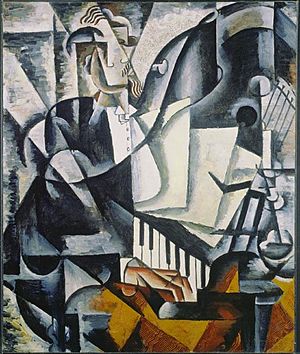
Lyubov Popova was one of the first women to explore Cubo-Futurism. This style mixed ideas from Cubism and Futurism. She aimed to create what she called painterly architectonics. This meant building paintings with shapes and colors, like an architect builds a building.
She first tried Impressionism. But by 1913, in her painting Composition with Figures, she was trying out Cubo-Futurism. This was a special Russian art style that combined French and Italian influences.
From 1914 to 1915, her home in Moscow became a meeting place for artists and writers. Between 1914 and 1916, Popova showed her work in important avant-garde exhibitions. These included the Knave of Diamonds shows, Tramway V, 0.10, and The Store. Her Cubo-Futurist work also looked similar to the paintings of Fernand Léger. He used tubular and cone shapes in his art.
Suprematism: Abstract Art for a New World
Her painting The Violin from 1914 shows how her art changed. It moved from Cubism towards her "painterly architectonics" series. This series, from 1916 to 1918, showed her unique path in abstract art. Abstract art uses shapes, colors, and lines instead of showing real objects.
In these paintings, the canvas looked like an energy field. It had many overlapping and crossing angular shapes. These shapes seemed to be full of energy, ready to burst. Yet, all the parts were balanced, connecting old art to the future. She used strong primary colors in the center to pull the other shapes together.
In 1916, Popova joined the Supremus group. This group was led by Kazimir Malevich, who started Suprematism. Other artists in the group included Aleksandra Ekster and Olga Rozanova. They worked in a place called Verbovka Village Folk Centre.
Creating new kinds of paintings was part of the revolutionary spirit of the Russian avant-garde. They wanted to remake the world through art. The word 'supreme' meant a 'non-objective' or abstract world. This was a world beyond everyday reality.
Some artists, like Malevich, saw art as a spiritual journey. Others believed artists should create a new physical world. Popova liked both ideas. But she eventually focused on supporting the October Revolution. She worked on posters, book designs, fabric, and theatre designs. She also taught art.
At the 0.10 exhibition, she showed some figurative cardboard reliefs. These were sculptures in a Cubist style. In 1916, she started painting completely abstract Suprematist works. But she called many of her paintings "Painterly Architectonics." This name suggests she saw painting as showing real space and materials. She was less interested in it as a personal, spiritual expression. Popova's layered shapes and strong colors made her art feel like real space and objects.
In 1918, Popova married an art historian named Boris von Eding. They had a son. Sadly, von Eding died the next year from typhoid fever. Popova also got very sick but recovered.
Constructivism: Art for Society
Even in 1917, while still doing Suprematist work, Popova designed fabrics. She also worked on Agitprop books and posters. Agitprop was art used to spread political ideas. In 1918, she showed her architectonic paintings at the Tenth State Exhibition: Non Objective Creativity and Suprematism. She continued painting advanced abstract works until 1921.
At the 5x5=25 Exhibition in 1921, Popova and four other Constructivist artists made an important statement. They said that traditional easel painting should be stopped. They believed all creative work should be for the people and for building a new society.
Popova worked in many different art forms. These included painting, relief sculptures, and designs for theater, textiles, and books. She did not join the First Working Group of Constructivists right away in March 1921. But she joined by the end of that year. In 1923, she started creating designs for fabric. These fabrics were made at the First State Textile Printing Works in Moscow.
From 1921 to 1924, Popova focused completely on Constructivist projects. She sometimes worked with Varvara Stepanova, the architect Alexander Vesnin, and Alexander Rodchenko. Her "Spatial Force Constructions" were used to teach art at Vkhutemas. This was a famous art and technical school. She designed book typography, stage sets, and textiles. She also designed dresses for the magazine LEF. She worked for a short time at the Cotton Printing Factory in Moscow with Varvara Stepanova.
Her Later Life and Legacy
Lyubov Popova died in Moscow in 1924. She was at the peak of her artistic career. She passed away two days after her son died. She had caught scarlet fever from him.
A large exhibition of her work opened in Moscow shortly after her death. It ran from December 21, 1924, to January 1925, at the Stroganov Institute. The exhibition showed 77 of Popova's paintings. It also included her books, posters, textile designs, and engravings. Her friends and fellow artists called her an "Artist-Constructor" in the exhibition catalog.
Later, in 2009, an exhibition called Rodchenko/Popova: Defining Constructivism was held. It showed the work of Popova, Rodchenko, and other Constructivist artists. It was shown at Tate Modern in London and later at Museo Reina Sofia in Madrid.
Exhibitions
| 1910 | Knave of Diamonds I, Moscow |
| 1912 | Knave of Diamonds II, Moscow |
| 1915 | The Futurist Exhibition: Tramway V, Petrograd |
| 1916 | 0.10, Petrograd |
| 1916 | The Store, Moscow |
| 1918 | Tenth State Exhibition: Non-Objective Creativity and Suprematism, Moscow |
| 1921 | 5x5=25, Moscow |
Gallery
-
Lyubov Popova, Untitled, 1915, Oil on canvas, 106.4 × 71.1 cm (41.9 × 28 in), Solomon R. Guggenheim Museum, New York Gift, George Costakis, 1981 Guggenheim Museum
-
Lyubov Popova, Birsk, 1916, Oil on canvas, 106 × 69.5 cm (41.7 × 27.4 in), Solomon R. Guggenheim Museum, New York Gift, George Costakis, 1981 Guggenheim Museum
See also
 In Spanish: Liubov Popova para niños
In Spanish: Liubov Popova para niños
- List of Russian artists


